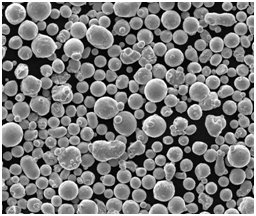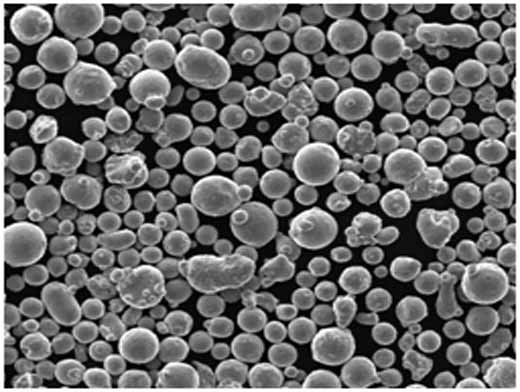Aperçu de la poudre de CuSnTi
Poudre de CuSnTi est une poudre unique d'alliage de cuivre, d'étain et de titane couramment utilisée dans les industries de fabrication de pointe. Ses propriétés exceptionnelles - résistance à la corrosion, durabilité et stabilité thermique - en font un matériau idéal pour les secteurs de l'aérospatiale et de l'électronique. Dans cet article, nous allons détailler les qualités spécifiques, les applications et les principaux modèles de produits de la poudre CuSnTi.
Que vous soyez acheteur, ingénieur ou simplement curieux au sujet de la poudre de CuSnTi, ce guide couvre tout ce dont vous avez besoin.
Principaux thèmes abordés
- Qu'est-ce que la poudre de CuSnTi ?
- Compositions et propriétés détaillées
- Applications dans tous les secteurs d'activité
- Spécifications, tailles et qualités
- Avantages et inconvénients des différents modèles de poudres CuSnTi
- FAQ et avis d'experts

Composition de la poudre de CuSnTi
La poudre CuSnTi contient généralement du cuivre (Cu), de l'étain (Sn) et du titane (Ti) comme éléments primaires. La composition exacte varie d'un modèle à l'autre, influençant des caractéristiques telles que le point de fusion, la résistance à la corrosion et la compatibilité avec différents processus de fabrication. Nous détaillons ici les spécificités de la composition pour vous aider à comprendre ce qui différencie chaque modèle.
| Modèle à poudre | Cuivre (%) | Étain (%) | Titane (%) | Éléments supplémentaires |
|---|---|---|---|---|
| Modèle A | 75 | 20 | 5 | Aucun |
| Modèle B | 70 | 25 | 5 | Traces de fer |
| Modèle C | 68 | 30 | 2 | Bore pour une meilleure résistance |
| Modèle D | 80 | 15 | 5 | Molybdène pour la ténacité |
| Modèle E | 65 | 25 | 10 | Nickel pour une meilleure résistance à la corrosion |
| Modèle F | 60 | 30 | 10 | Zinc pour une dureté accrue |
| Modèle G | 72 | 18 | 10 | Aucun |
| Modèle H | 78 | 12 | 10 | Chrome pour la stabilité thermique |
| Modèle I | 62 | 28 | 10 | Phosphore pour faciliter la coulée |
| Modèle J | 64 | 26 | 10 | L'aluminium pour plus de légèreté |
Caractéristiques de la poudre de CuSnTi
Les propriétés de la poudre CuSnTi dépendent fortement des rapports de composition du cuivre, de l'étain et du titane, chacun apportant des qualités uniques. Voici un aperçu des principales caractéristiques qui font de la poudre CuSnTi un choix populaire pour les applications à forte demande :
| Caractéristique | Description |
|---|---|
| Résistance élevée à la corrosion | La poudre CuSnTi résiste à la rouille et à la corrosion, ce qui la rend idéale pour les pièces exposées à l'humidité ou aux produits chimiques. |
| Conductivité thermique | Grâce à son excellente conductivité thermique, le CuSnTi est idéal pour les applications d'échange de chaleur, qu'il s'agisse de refroidir des appareils électroniques ou de fabriquer des produits à haute température. |
| Solidité et durabilité | L'ajout de titane améliore la résistance à la traction et la durabilité, ce qui permet aux pièces de résister à une utilisation intensive dans des conditions difficiles. |
| Malléabilité | Il est modérément malléable, ce qui permet de le façonner ou de le mouler, mais sa dureté est supérieure à celle des poudres de cuivre pur. |
| Résistance à l'usure | La structure de l'alliage contribue à la résistance à l'usure, ce qui le rend approprié pour les composants qui subissent des frottements. |
| Composition légère | Malgré sa résistance, le CuSnTi est relativement léger par rapport à d'autres poudres métalliques ayant une durabilité similaire, ce qui améliore l'efficacité des pièces aérospatiales. |
| Résistance à l'oxydation | Très résistant à l'oxydation, il conserve son intégrité structurelle même lorsqu'il est exposé à l'air ou à l'eau pendant de longues périodes. |
Applications de la Poudre de CuSnTi
La poudre de CuSnTi trouve des applications dans diverses industries en raison de ses qualités robustes. Voici un aperçu des domaines dans lesquels elle est couramment utilisée et des raisons pour lesquelles elle l'est :
| L'industrie | application | Pourquoi la poudre CuSnTi est-elle idéale ? |
|---|---|---|
| Aérospatiale | Composants de moteurs à réaction, supports structurels | Léger et durable, il est capable de résister à des températures et à des contraintes élevées. |
| Automobile | Engrenages, pistons et roulements | Résiste à l'usure, idéal pour les pièces mobiles exposées à la friction et à la chaleur. |
| Électronique | Dissipateurs thermiques, circuits imprimés | Une conductivité thermique élevée facilite la gestion de la chaleur, ce qui est essentiel pour la stabilité et la longévité de l'électronique. |
| Dispositifs médicaux | Instruments chirurgicaux, composants implantables | Biocompatible et résistant à la corrosion, il peut être utilisé en toute sécurité dans le corps humain. |
| Marine | Pales d'hélice, raccords sous-marins | Résistance exceptionnelle à la corrosion, essentielle pour les pièces exposées à l'eau salée et aux environnements marins. |
| Fabrication | Plaquettes pour moules, outils de coupe | Grande solidité et résistance à la déformation, idéal pour les moules et l'outillage qui subissent des contraintes et une usure importantes. |
| La construction | Renforcements structurels, raccords | Durable, résistant à la corrosion et rentable pour l'intégrité structurelle. |
| Bijoux | Composants décoratifs, montres haut de gamme | Coloration unique et résistance au ternissement, idéales pour une longévité esthétique et fonctionnelle. |
| Impression 3D | Fabrication additive métallique pour les prototypes | Le grain fin de la poudre permet une stratification précise, parfaite pour les prototypes haute définition et les pièces personnalisées. |






Spécifications, tailles, qualités et normes pour la poudre de CuSnTi
Le choix de la bonne poudre de CuSnTi dépend souvent des spécifications de votre projet, qui peuvent exiger des qualités, des tailles de particules ou des normes de conformité spécifiques.
| Grade | Gamme de taille des particules (µm) | Conformité aux normes | Description |
|---|---|---|---|
| Note 100 | 10-20 | ASTM B213 | Convient aux applications fines comme l'impression 3D et le moulage de précision. |
| Grade 200 | 20-50 | ISO 3923-1 | Idéal pour les pièces automobiles moyennement détaillées et très résistantes. |
| Grade 300 | 50-100 | ASTM B962 | Grain plus grossier, adapté aux renforcements structurels et aux applications lourdes. |
| Grade 400 | 10-45 | AMS 4990 | Poudre de qualité aérospatiale répondant à des exigences élevées en matière de durabilité et de résistance thermique. |
| Grade 500 | 30-70 | JIS Z2505 | Qualité polyvalente pour un usage industriel général, offrant un bon équilibre entre résistance et malléabilité. |
| Grade 600 | 70-150 | EN 13942 | Idéal pour les composants structurels de grande taille qui ne nécessitent pas une grande précision, tels que les inserts de moule et l'outillage. |
| Classe 700 | 15-35 | ASTM B329 | Conçu pour les dissipateurs de chaleur et les pièces de gestion thermique en raison de sa conductivité supérieure. |
Comparaison des avantages et des inconvénients des modèles de poudres CuSnTi
Les différents modèles présentent des avantages et des inconvénients spécifiques en fonction de leur composition et des applications prévues. Voici une comparaison :
| Modèle à poudre | Avantages | Inconvénients |
|---|---|---|
| Modèle A | Rentable, bon pour un usage général | Résistance à la corrosion plus faible que d'autres |
| Modèle B | Excellente solidité et résistance à l'usure | Coût légèrement plus élevé en raison des éléments ajoutés |
| Modèle C | Excellente gestion de la chaleur, durabilité équilibrée | Moins malléable pour les dessins complexes |
| Modèle D | Résistant et durable, idéal pour une utilisation structurelle | Plus lourd que les autres poudres |
| Modèle E | Haute résistance à la corrosion, légèreté | Coût plus élevé en raison de l'ajout de nickel |
| Modèle F | Dureté élevée, bonne pour les machines | Conductivité thermique plus faible |
| Modèle G | Polyvalent, convient à la fois à l'automobile et à l'aérospatiale | Moins efficace en milieu salin |

FAQ
| Question | Réponse |
|---|---|
| À quoi sert principalement la poudre de CuSnTi ? | La poudre de CuSnTi est couramment utilisée dans l'aérospatiale, l'automobile, l'électronique et les appareils médicaux pour sa solidité et sa résistance. |
| Comment choisir la bonne qualité de poudre CuSnTi ? | Tenez compte des exigences de l'application, telles que la taille des particules, la durabilité et les normes industrielles spécifiques. |
| La poudre CuSnTi est-elle adaptée à l'impression 3D ? | Oui, en particulier dans les qualités fines ; il offre une bonne précision et une bonne durabilité pour la fabrication additive. |
| Comment la poudre CuSnTi se compare-t-elle au cuivre pur ? | Il offre une meilleure résistance à la corrosion, une meilleure durabilité et une meilleure stabilité thermique, bien qu'il soit légèrement moins conducteur. |
| Quel est le coût de la poudre de CuSnTi ? | Les prix varient en fonction de la composition et de la qualité, généralement de 50 à 150 $ par |

